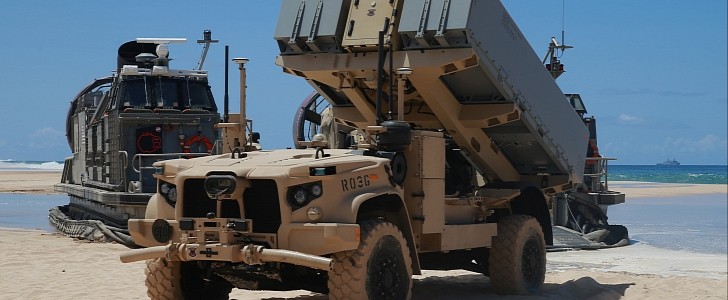During Large Scale Exercise 21 (LSE 21), the U.S. Navy and Marine Corps successfully tested its new NMESIS anti-ship system on a retired frigate off the coast of Hawaii. The exercise demonstrated the capabilities of the U.S. maritime forces to unleash lethal, integrated all-domain naval power.
LSE 21 was a globally integrated, live scenario-driven exercise with activities that tested and evaluated warfighting principles that will determine how the future Navy and Marine Corps compete, respond to crises, fight, and win in combat.
During the exercise, the U.S. Navy and Marine Corps successfully tested the Navy-Marine Expeditionary Ship Interdiction System (NMESIS). The system, which is around two years old, consists of an unmanned Joint Light Tactical Vehicle, also known as the Remotely Operated Ground Unit Expeditionary-Fires (ROGUE-Fires), and a launcher with ready-to-fire naval strike missiles.
Since NMESIS is not a fielded capability yet, the fire control component of the system was controlled by MCSC engineers throughout the exercise. Marines, on the other hand, were able to practice navigating the system and test its operability with their Naval and Air Force partners.
SINKEX, the exercise scenario incorporating NMESIS, provided a testing environment for new and evolving technologies to connect, find, identify, target, and eliminate enemy threats in all domains, culminating in a live-fire demonstration of the naval strike missile against a sea-based target.
“This week was very successful,” said McPherson, long-range fires program manager at MCSC. “In addition to the two live fire shots that hit the target, we also successfully deployed the system aboard the Marine Corps’ primary transport systems, the C130 and LCAC.”
“This exercise gave us an opportunity to not only measure, but also validate the concepts for the Marine Corps’ anti-ship capability, which is one of the most important avenues of the Commandant’s Force Design 2030,” said Lieutenant Col. Ryan Collins, combat integration office for artillery and fires at Marine Corps Combat Development Directorate, Combat Development and Integration.
During the exercise, the U.S. Navy and Marine Corps successfully tested the Navy-Marine Expeditionary Ship Interdiction System (NMESIS). The system, which is around two years old, consists of an unmanned Joint Light Tactical Vehicle, also known as the Remotely Operated Ground Unit Expeditionary-Fires (ROGUE-Fires), and a launcher with ready-to-fire naval strike missiles.
Since NMESIS is not a fielded capability yet, the fire control component of the system was controlled by MCSC engineers throughout the exercise. Marines, on the other hand, were able to practice navigating the system and test its operability with their Naval and Air Force partners.
SINKEX, the exercise scenario incorporating NMESIS, provided a testing environment for new and evolving technologies to connect, find, identify, target, and eliminate enemy threats in all domains, culminating in a live-fire demonstration of the naval strike missile against a sea-based target.
“This week was very successful,” said McPherson, long-range fires program manager at MCSC. “In addition to the two live fire shots that hit the target, we also successfully deployed the system aboard the Marine Corps’ primary transport systems, the C130 and LCAC.”
“This exercise gave us an opportunity to not only measure, but also validate the concepts for the Marine Corps’ anti-ship capability, which is one of the most important avenues of the Commandant’s Force Design 2030,” said Lieutenant Col. Ryan Collins, combat integration office for artillery and fires at Marine Corps Combat Development Directorate, Combat Development and Integration.






